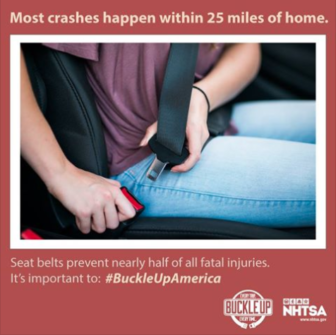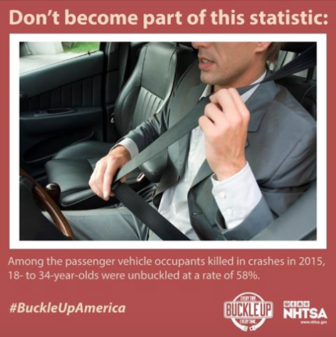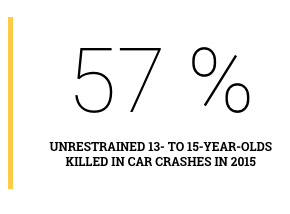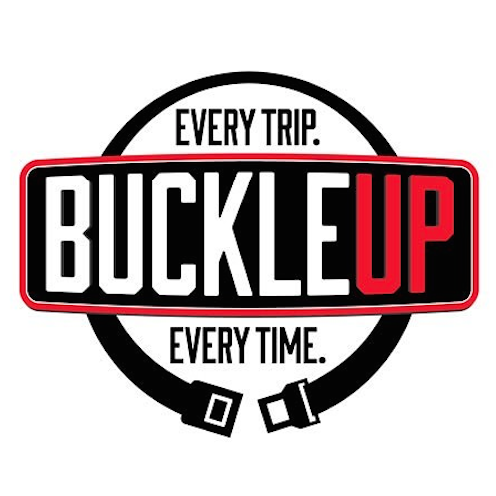During the busy Thanksgiving travel period, the Darien Police Department and other police agencies will be on the lookout for drivers and passengers without seat belts.
 Police agencies across the country are partnering with the U.S. National Highway Traffic Safety Administration (NHTSA) for this year’s Click It or Ticket campaign.
Police agencies across the country are partnering with the U.S. National Highway Traffic Safety Administration (NHTSA) for this year’s Click It or Ticket campaign.
The Thanksgiving holiday is one of the busiest travel times of the year, which means more vehicles will be on the roads. Increased vehicle activity leads to the potential for more crashes and more fatalities.
Failing to buckle up puts you and other vehicle passengers in a potentially deadly situation. It’s also against the law — plain and simple. There’s never an excuse to not wear your seat belt.
Wearing a seat belt is the single most effective way to save your life and the lives of your loved ones while on the road this Thanksgiving.
Anyone found breaking the state seat belt law will face fines from $92 to $120.
Not Buckling Up Can Be Deadly
 During the Thanksgiving holiday weekend in 2015 (6 p.m., Wednesday to 5:59 a.m., Monday), 301 people in passenger vehicles died in traffic crashes nationwide, down from the 341 people killed in 2014.
During the Thanksgiving holiday weekend in 2015 (6 p.m., Wednesday to 5:59 a.m., Monday), 301 people in passenger vehicles died in traffic crashes nationwide, down from the 341 people killed in 2014.- It’s deadlier at night in terms of seat belt use. Over the 2015 Thanksgiving weekend, 57 percent of people killed in crashes at night were unbuckled, compared to 49 percent during the day.
- During all of 2015, a total of 22,441 passenger vehicle occupants were killed in crashes, and nearly half (44 percent) of them were not wearing their seat belts at the time of the crash. Among passenger vehicle occupant fatalities in 2015, the age groups of 13-15 and 18-34 had the highest percentages (57 percent and 58 percent, respectively) of occupants who were unbuckled at the time of their fatal crash.
Seat Belts Save Lives
 According to NHTSA, seat belts saved about 13,941 lives nationwide age 5 and older in 2015. If everyone had worn seat belts that year, an additional 2,804 lives could have been saved.
According to NHTSA, seat belts saved about 13,941 lives nationwide age 5 and older in 2015. If everyone had worn seat belts that year, an additional 2,804 lives could have been saved.- Proper seat belt use reduces the risk of fatal injury to front seat passengers by 45 percent and the risk of moderate to serious injury by 50 percent.
- Ejection from a vehicle is one of the most dangerous events that can happen to a person in a crash. In fatal crashes in 2015, almost 8 out of 10 (80 percent) of the passenger vehicle occupants who were totally ejected from vehicles were killed. Wearing your seat belt is the most effective way to prevent ejections; only 1 percent of the occupants reported to have been wearing their seat belts were totally ejected in a crash, compared to 30 percent who were unbuckled.
This Thanksgiving — and every day of the year — remember, Click It or Ticket. For more information, please visit www.nhtsa.gov.
Most Teens Killed in Crashes Aren’t Buckled Up
Here’s what the National Highway Traffic Safety Administration has to say about that (from its website):
You’re the #1 Influence: Make Sure Your Tween is Properly Buckled Up the Whole Ride, Every Time
Seat Belt Safety Starts With Good Role Models
Learning the importance of wearing a seat belt starts with a good role model—and that’s you. As a parent or caregiver, you are the number one influence on your child’s seat belt safety. Research shows that children whose parents buckle up are much more likely to buckle up themselves.
Consistency is Key
Consistently remind your children to buckle up properly the whole ride, and never assume they’re buckled up! Learn tips to motivate your tweens to buckle up, and make it a rule in your family that everyone follows the same practices as you: Always buckle up before moving the car, no matter how short or routine the drive, and make sure all children are buckled up properly.
The Proper Seat Belt Fit for Your Child
The risk of injury among child passengers is significantly higher when their seat belts are loose and/or improperly positioned. Learn about the proper seat belt fit for your child and why your children may not be wearing their seat belts correctly.
Front or Back—When is the Front Seat Safe for My Child?
All children under age 13 should ride in the back seat for maximum safety. The back seat is the safest place for your children because most crashes occur in the front of the car and the back seat is farthest from this impact.
Why Parents and Caregivers Forget About or Forego Seat Belt Safety
We know life as a parent is full of distractions and often hectic, making it easy to forget or forego buckling up altogether. See if any of these excuses for not buckling up sound familiar, then do whatever it takes to buckle up and make sure your kids do the same:
- Rushed and chaotic pre-travel routines
- Distractions
- Need to minimize conflict or keep the peace
- Seat belt discomfort or perceived nuisance when in a hurry
- Shorter distances, slower speeds and familiar roads falsely associated with lower risk
- Kids persistently asking to ride in the front seat
Tips to Motivate Your Tweens to Buckle Up
Getting your kids to properly buckle up and stay buckled can be a battle of wills. There are several reasons why children 8 to 14 may forget or not want to wear their seat belts. For as many reasons as your kids can protest against wearing a seat belt, we’ve got tips to help you motivate them to buckle up.
Tweens are going through several developmental stages—social, cognitive and emotional—which offer helpful insights into what makes sense to them and what motivates them. Learn about the developmental stages and motivational messages get your kids to buckle up properly, the whole ride, every time.
It’s Non-Negotiable: Tween Seat Belt Safety
We know you make every effort to keep your kids safe. However, parenting can be a hectic job. The daily routine of getting your kids to and from school and other activities can be hurried and chaotic, creating an environment where insisting on wearing a seat belt is not top of mind. See if you face these five challenges to getting tweens to wear — and stay in — their seat belts.
No Matter How Hurried or Chaotic, Don’t Negotiate!
As a parent, sometimes you let your kids have their way. But their safety should never be up for negotiation, no matter how much they push back on the seat belts being uncomfortable or unnecessary for just a “short drive.” Here are some tips to help you win the seat belt battle:
- Consistently Model Seat Belt Safety. Teaching your children to consistently wear seat belts can take a great deal of resolve. Your first line of defense, as your children’s number one influence, is to wear your seat belt and insist that all family members do the same.
- Never Give Up Until They Buckle Up. Make sure your kids are buckled up with their lap and shoulder belt—no shoulder belts behind their backs or under their arms, or seat belts so loose that they can wrestle in the back seat. Learn how to motivate your kids to buckle up properly and consistently using age-appropriate messages and rewards to reinforce the importance of seat belt safety.
- Never Assume Your Kids Are Buckled Up. One conversation is not enough: Remind your children to wear their seat belts every time they get into a car—no matter whose car it is—and stay buckled up, including at night and on longer rides.Teenagers
 It’s been a long time since your little ones transitioned from a booster seat into an adult seat belt, and now they’re teenagers. Think it’s time to relax? Think again. The majority of teens involved in fatal crashes aren’t wearing their seat belts.
It’s been a long time since your little ones transitioned from a booster seat into an adult seat belt, and now they’re teenagers. Think it’s time to relax? Think again. The majority of teens involved in fatal crashes aren’t wearing their seat belts.
Buckling up is not a one-time conversation — it’s ongoing. Set the example by always wearing your seat belt, and remind your teens buckling up is the law.
To learn more, visit our Teen Driving section.

